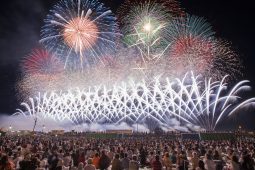Fifteen years ago, I would often have to explain that no, really, Japanese fireworks are a cut above the rest, and anyone who comes here in summer owes it to themselves to see it. These days, I think the sentiment’s finally sunk in (and this site itself has other articles on the subject), so I doubt I need to repeat the point. On the other hand, if you would like a demonstration, the clip below is from a moderately sized fireworks show; if you’d like to see more, I would personally recommend finding clips of the Kashiwazaki Gion festival, one of my favourites (and more or less local).
So if an hour or two spent watching elaborate, beautiful and incredibly loud explosions sounds like fun, I strongly recommend attending a few. They don’t charge (unless you go for premium seats), and they’re just about everywhere, like festivals. You will probably run into a couple in the course of summer just by accident.
Just in case you’re going off the beaten path rather than working from a top 10 list, though, this article will cover some ways to tell, at a glance, how good a show is likely to be. If you are working from a list, then this article will still have some advice on how to make the most of attending a fireworks show.
There are a few ways to guess the quality of a show, including reviews, but for this article I’ll focus on options that don’t take any Japanese skill. First, find out how long the show is; this might be difficult, since events in Japan can be very vague about when they end. Look for something ending in 分. For example, 30分 would be 30 minutes (in general, they’re 90-120 minutes).
Now, look for the number of fireworks, a number followed by either 発 or, rarely, 本. Between the two, you can tell how active a show is. A ninety-minute show can be very different depending on whether they’re firing everything they’ve got or trying to stretch a few fireworks as far as they’ll go!
Check the weather, and how they plan to adapt to it. 雨天決行 means they’ll carry on if it rains (but you had better be prepared for bad weather if it looks likely). 雨天中止 means it’s cancelled, and anything else probably means they’ll reschedule; this goes for any events in Japan and can be a useful thing to check for, especially in summer.
Finally, look at the size of the fireworks if you can find any information. These are usually listed as a number followed by 号. The higher the number, the bigger the firework. Anything larger than a 10 moves to its own class, 尺玉(shaku-dama). These usually have numbers in kanji, so in ascending order, they are: 一尺玉, 二尺玉, 三尺玉. There is a four, but currently only the Katakai festival (which just happens to be in my home prefecture) has one. Looking at this will, in short, tell you how good the fireworks are. If you see スターマイン(Starmine), by the way, that means a rapid-fire session of lots of small fireworks.
Except for Kashiwazaki which does that with shaku-dama, but unfortunately that’s not the standard way.
So you’ve chosen a show to attend, and now you need to know how to prepare. First, budget your time. Yes, it may say ‘ninety minutes’ or something, but in practice you have to devote a day to it unless you’re very nearby. If it’s at all a major event, traffic there will be severe. You need to be there hours in advance to stake out a spot, especially if it has a good view of the launches. Then, after it ends, it can take hours for traffic to meaningfully clear, while trains will be very packed. If you’re taking a train… well, good luck. You’ll be on time but you’ll definitely have to stand. If you came by car, my advice is to just take it easy for a while. Sometimes people try to ‘beat the rush’ by leaving ten minutes early, but that doesn’t accomplish anything other than missing the best part of the show. Relax a bit, and wait for the traffic to clear so you can drive home without any frustration. Trust me, you won’t get home any later for it. This does mean you need to plan around the whole event taking a few extra hours on either side, though, if it’s big.
Besides that, you’ll want to bring a few things. The most obvious one is a mat, whether it’s foam, a cloth or something else; you’re in the open air, and you would probably prefer not to sit directly on grass or concrete. That, and if you weigh it down, it’s a good way to mark your spot; nobody’s going to move it out of the way.
Pack a jacket or something in case the night gets colder as it wears on. This one is especially true for shows over the sea (a lot of them), since the wind can make even a summer night a bit chilly. Try to get some drinks beforehand, because local convenience stores will be absolutely packed, and vending machines empty.
Bring some food, or don’t. Fireworks shows are often part of a larger festival (which, by the way, means there may well be other events to see too!), and that means stalls with all sorts of food. On the other hand, ‘all sorts’ tends to revolve around fried food, batter, potato and sometimes meat (and some other miscellaneous, sometimes fruit-based sweets), so if that’s not something you can eat, or you don’t want to count it as a full meal, bring your own.
Finally, get a small hand towel. The weather is hot and humid enough that you might want it already in summer, but in particular, I’m thinking of times when the wind changes and blows the accumulated smoke of the fireworks onto the audience. It’s not as bad as it sounds, but in case it does happen, having a towel on hand to breathe through for a few minutes can help a lot.
Once all that’s taken care of, all that’s left is to get out there and stare at pretty lights for an evening. Have fun!








